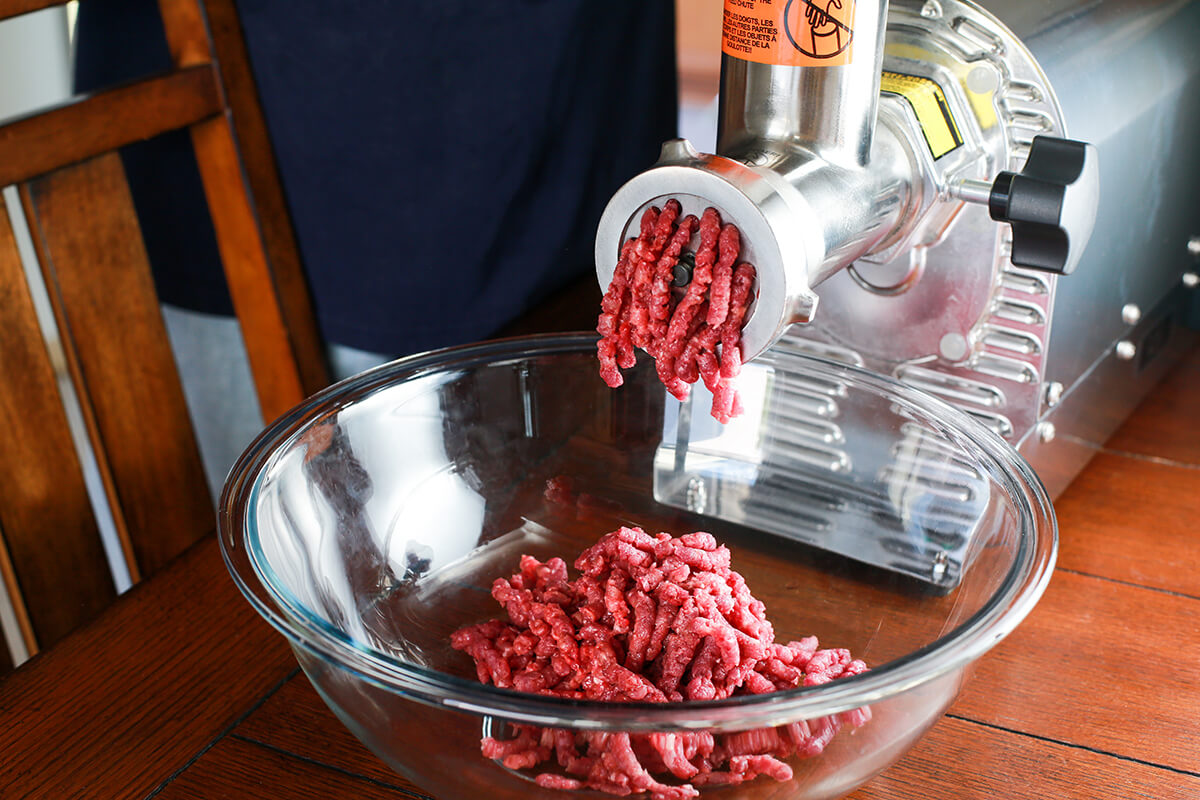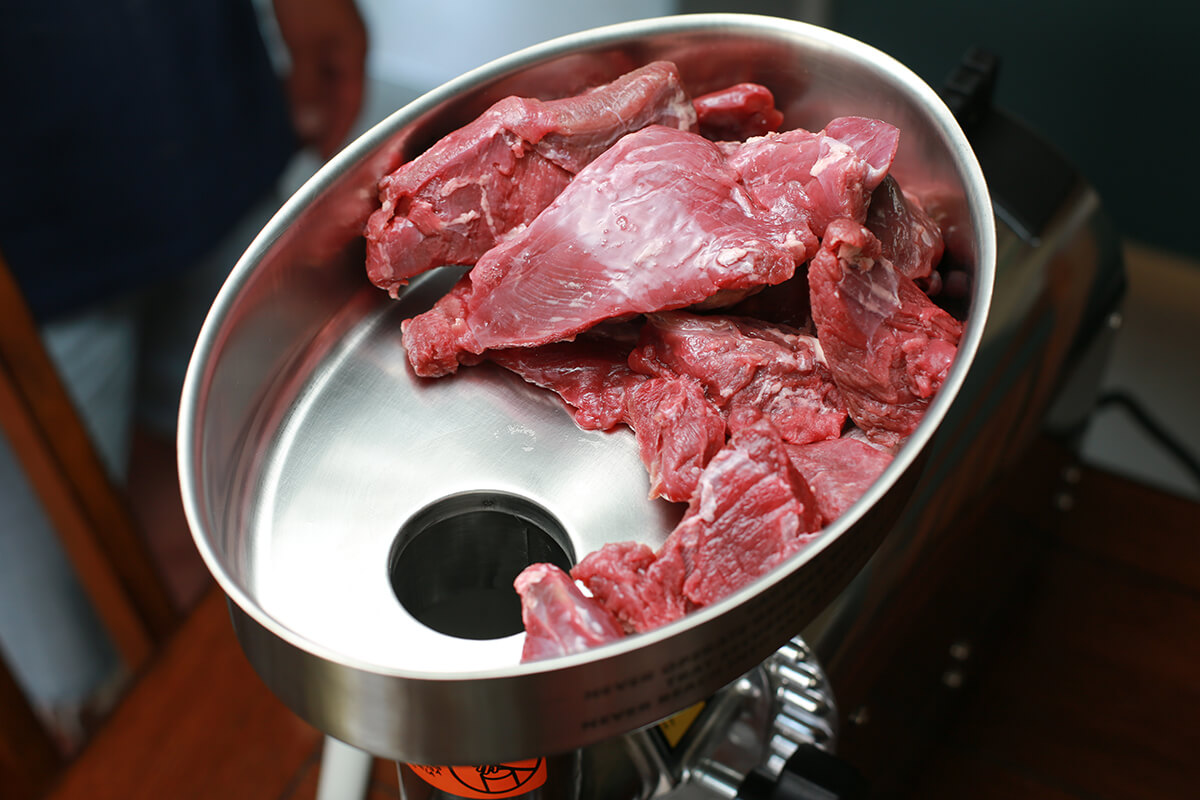
Freshly-ground venison tastes best and you can make your own at home by following these whitetail deer grinding tips. (Jenny Nguyen-Wheatley photo)
Print Recipe
For whitetail deer hunters, grinding venison is one of the best and easiest ways to utilize this wild game meat. You don’t have to worry about overcooking ground meat, and you don’t have to wait hours for a slow cooker to do its magic.
For treatments such as steaks and roasts, does and young bucks are often preferable. But for the trophy hunter, grinding older, tougher whitetail bucks is probably the best way to eat it. I personally am not a trophy hunter, but I do get a lot of meat “donations” from friends who are. I’ve found that while old whitetails don’t make the best steak dinner, they do make delicious, flavorful ground meat.
Here is what you need to do for the best ground venison.
Preparing the Meat for Grinding
Save the loins and tenderloins for your grill, and use only the quarters for grinding. But first, you must remove the bone from the meat. For better control and power, a sharp, stiff boning knife or a fillet knife works best on deer. For example, a fillet knife designed for processing fish would be much too flexible for getting around a deer’s thick bones and joints.

Next, remove as much silver skin as possible from the meat. Many people skip this step, but I find that removing it creates a better product in the end. Silver skin is tasteless and does nothing to enhance ground meat. I’ve also found that too much silver skin can prevent your ground venison from binding together for recipes such as burgers and meatballs. Don’t worry about removing every bit possible – just focus on large, thick areas.
Make sure to remove as much fat as possible from the meat. Most off-putting flavors in venison is stored in the animal’s fat. Also, venison fat is the kind that unpleasantly coats your palate with a waxy texture.
Keep It Cold
Then cut the meat into large chunks – whatever size your grinder can easily take. Place meat pieces onto a cookie sheet lined with parchment paper, making sure they don’t touch. Chill in your freezer for about 30 minutes or until the meat becomes firm to the touch, but not frozen through. This will help prevent bacteria from growing, as well as help your grinder work more efficiently; soft, sticky meat is more difficult to mince than firm meat. Additionally, as your grinder operates, friction will also warm up the machine. You can also take the extra precaution of chilling the grinder attachments in the freezer before using them.

Add Fat
Depending on what you’re planning to cook, you may want to add fat to your ground venison. This added fat can be bacon, pork shoulder, pork belly, beef tallow, etc. It’s purely personal preference.
I always add about 15-20 percent fat if I’m making hamburger or kebabs, which makes the meat juicier and more flavorful. But for recipes such as taco meat, meatloaf, meatballs, meat sauces, etc., I do not add fat, especially if the meat requires simmering in a sauce or has other moisture-enhancing ingredients in it such as egg, milk and/or breadcrumbs.
To add fat to venison, cut it up into pieces and chill in the freezer as described in the previous section.
Grinding
Thoroughly read the instructions that came with your grinder. Fit the grinder with the coarse ground die, and once ready, add the chilled wild game and fat into the tray and grind together. Try not to handle the meat more than you have to, to keep it cold and firm. Some people grind their meat twice, but I do it only once through the coarse die. I rarely use the fine die, unless if I plan on making ravioli filling or something that requires a smoother texture.
For the most part, I like my ground meat coarse and meaty. Too fine and ground meat takes on a mealy texture.

Grind Fresh or Store Tightly
Freshly ground meat is the best ground meat. When I make venison burgers, that meat is usually ground right before I cook it. This ensures that I’m cooking with freshly ground meat every single time, especially since I enjoy my burgers on the rarer side.
As mentioned previously, grinding meat creates lots of surface area where bacteria can attach and grow. Additionally, pre-grinding meat exposes more air to the meat, which causes discoloration during grinding, then freezing and then thawing.
However, this may not be feasible for most people. Dragging out the meat grinder before every meal is a chore. If you choose to grind large bulks of meat beforehand, I suggest vacuum sealing that ground meat instead of using the typical freezer bags/sleeves for long term storage. These bags are not airtight, and your ground meat will not last as long in the freezer.
Another trick I’ve learned to grind small batches of venison is to use a food processor. Follow the previous steps, except cut venison into smaller pieces than normal, and pulse the semi-frozen meat (and fat, if desired) in small batches to prevent overwhelming the machine. For small batches of ground venison, this method works very well and can be utilized for all kinds of meat.











































